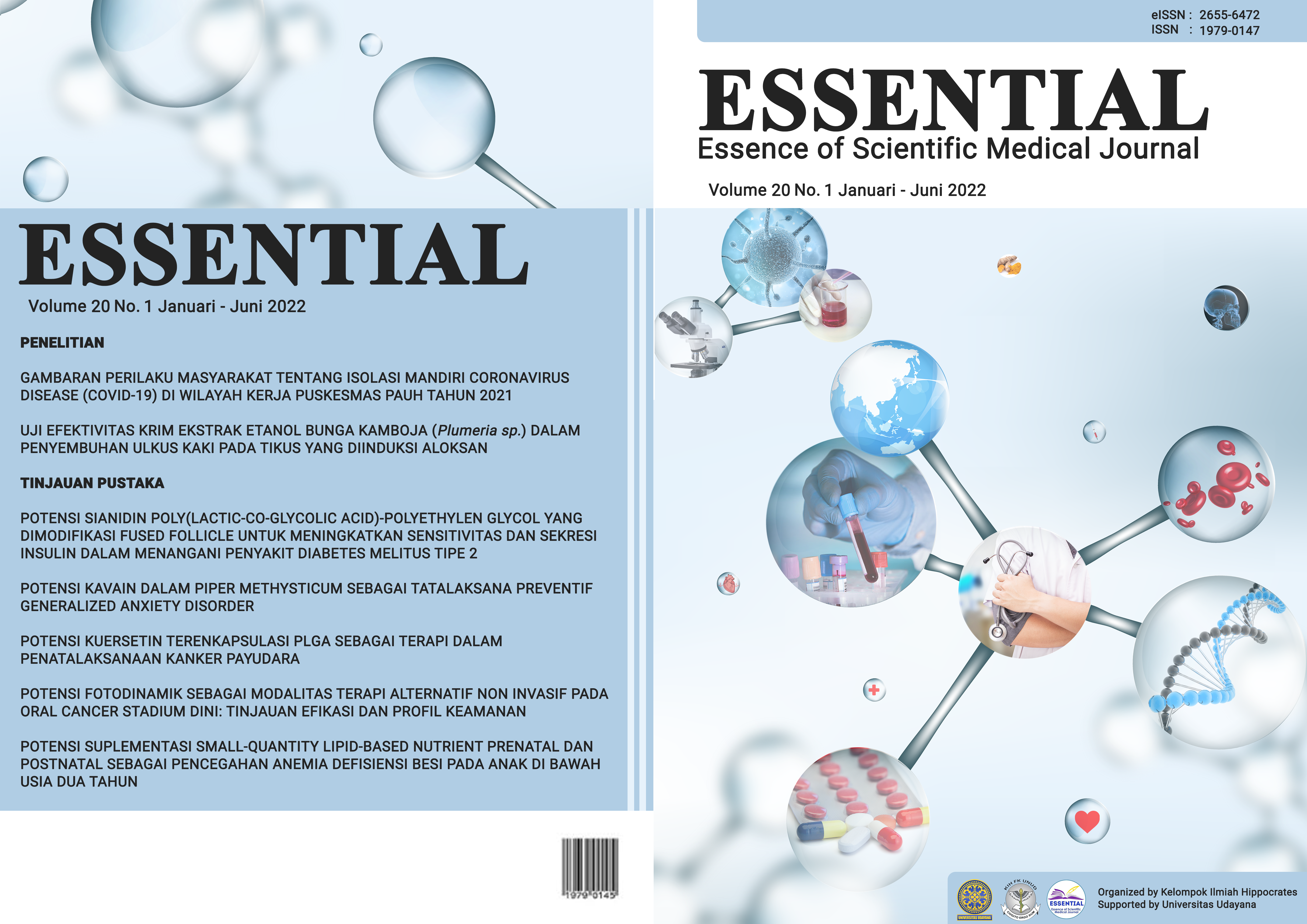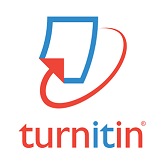Potensi Kuersetin Terenkapsulasi PLGA sebagai Terapi dalam Penatalaksanaan Kanker Payudara
Abstract
Pendahuluan: Kanker payudara adalah jenis kanker utama yang terlibat dalam kematian wanita di dunia. Kanker ini merupakan salah satu kanker yang paling umum diderita di seluruh dunia dengan angka kejadian sekitar dua juta kasus per tahun. Kuersetin merupakan jenis senyawa aktif flavonoid. Senyawa aktif ini menginduksi apoptosis sel dan mempengaruhi siklus sel sehingga berpotensi dalam pengobatan kanker payudara. Akan tetapi efek kuersetin memilik keterbatasan pada sifatnya yang larut dalam air, tidak stabil pada struktur kimianya, serta sukar diserap pada jalur gastrointestinal sehingga bioavaibilitasnya buruk. Formulasi nano dari kuersetin dengan memanfaatkan Poly (lactic-co-glycolic acid) PLGA dapat menjadi pilihan dalam meningkatkan efek anti-kanker dari kuersetin.
Pembahasan: Hasil tinjauan pustaka pada berbagai studi literatur menunjukkan bahwa kuersetin terenkapsulasi PLGA menunjukkan peningkatan aktivitas apoptosis (dini, terlambat) secara dignifikan sebesar 53,37% dan 6,78% dibandingkan dengan kontrol dan PLGA. Dibandingkan dengan PLGA tanpa kuersetin, kuersetin yang dienkapsulasi PLGA mampu memiliki aktivitas anti kanker yang sangat baik dengan menurunkan viabilitas sel hingga 40% dalam kisaran konsentrasi 0-2 µg. / mL.
Simpulan: Oleh karena itu terapi kuersetin terenkapsulasi PLGA dalam penatalaksanaan kanker payudara memiliki potensi yang menjanjikan sehingga diperlukan penelitian lebih lanjut.
Downloads
References
2. Harbeck N, Gnant M. Breast cancer. Vol. 389, The Lancet. Lancet Publishing Group; 2017. p. 1134–50.
3. Bray F, Ferlay J, Soerjomataram I, Siegel RL, Torre LA, Jemal A. Global cancer statistics 2018: GLOBOCAN estimates of incidence and mortality worldwide for 36 cancers in 185 countries. CA Cancer J Clin [Internet]. 2018 Nov 1 [cited 2020 Dec 31];68(6):394–424. Available from: https://acsjournals.onlinelibrary.wiley.com/doi/full/10.3322/caac.21492
4. International Agency for Research on Cancer. Breast - Global Cancer Observatory [Internet]. World Health Organization. 2020 [cited 2020 Dec 31]. p. 1–2. Available from: https://gco.iarc.fr/today/data/factsheets/cancers/20-Breast-fact-sheet.pdf
5. Zheng SY, Li Y, Jiang D, Zhao J, Ge JF. Anticancer effect and apoptosis induction by quercetin in the human lung cancer cell line A-549. Mol Med Rep [Internet]. 2012 Mar [cited 2021 Jan 1];5(3):822–6. Available from: https://pubmed.ncbi.nlm.nih.gov/22200874/
6. Vidya Priyadarsini R, Senthil Murugan R, Maitreyi S, Ramalingam K, Karunagaran D, Nagini S. The flavonoid quercetin induces cell cycle arrest and mitochondria-mediated apoptosis in human cervical cancer (HeLa) cells through p53 induction and NF-κB inhibition. Eur J Pharmacol [Internet]. 2010 Dec 15 [cited 2021 Jan 1];649(1–3):84–91. Available from: https://pubmed.ncbi.nlm.nih.gov/20858478/
7. Staedler D, Idrizi E, Kenzaoui BH, Juillerat-Jeanneret L. Drug combinations with quercetin: Doxorubicin plus quercetin in human breast cancer cells. Cancer Chemother Pharmacol [Internet]. 2011 Nov [cited 2021 Jan 1];68(5):1161–72. Available from: https://pubmed.ncbi.nlm.nih.gov/21400027/
8. Reinboth M, Wolffram S, Abraham G, Ungemach FR, Cermak R. Oral bioavailability of quercetin from different quercetin glycosides in dogs. Br J Nutr [Internet]. 2010 Jul [cited 2021 Jan 1];104(2):198–203. Available from: https://pubmed.ncbi.nlm.nih.gov/20230651/
9. Almeida AF, Borge GIA, Piskula M, Tudose A, Tudoreanu L, Valentová K, et al. Bioavailability of Quercetin in Humans with a Focus on Interindividual Variation. Compr Rev Food Sci Food Saf [Internet]. 2018 May 1 [cited 2021 Jan 1];17(3):714–31. Available from: https://onlinelibrary.wiley.com/doi/full/10.1111/1541-4337.12342
10. Matoba T, Egashira K. Nanoparticle-mediated drug delivery system for cardiovascular disease. Vol. 55, International Heart Journal. International Heart Journal Association; 2014. p. 281–6.
11. Gagliardi M, Bertero A, Bifone A. Molecularly Imprinted Biodegradable Nanoparticles. Sci Rep [Internet]. 2017 Jan 10 [cited 2021 Jan 3];7(1):1–9. Available from: www.nature.com/scientificreports
12. Roubalová L, Purchartová K, Papoušková B, Vacek J, Kəen V, Ulrichová J, et al. Sulfation modulates the cell uptake, antiradical activity and biological effects of flavonoids in vitro: An examination of quercetin, isoquercitrin and taxifolin. Bioorganic Med Chem. 2015 Sep 1;23(17):5402–9.
13. Karthick V, Panda S, Kumar VG, Kumar D, Shrestha LK, Ariga K, et al. Quercetin loaded PLGA microspheres induce apoptosis in breast cancer cells. Appl Surf Sci. 2019 Sep 1;487:211–7.
14. Men K, Duan X, Wei Wei X, Ling Gou M, Juan Huang M, Juan Chen L, et al. Nanoparticle-Delivered Quercetin for Cancer Therapy.
15. Araújo KCF, Eula EM, Pazini F, Valadares MC, De Oliveira V. Bioconversion of quercetin and rutin and the cytotoxicity activities of the transformed products. Food Chem Toxicol. 2013 Jan 1;51(1):93–6.
16. Kawai Y. β-Glucuronidase activity and mitochondrial dysfunction: the sites where flavonoid glucuronides act as anti-inflammatory agents. J Clin Biochem Nutr [Internet]. 2014 [cited 2021 Jan 1];54(3):145–50. Available from: http://jlc.jst.go.jp/DN/JST.JSTAGE/jcbn/14-9?lang=en&from=CrossRef&type=abstract
17. Yeh SL, Lin YC, Lin YL, Li CC, Chuang CH. Comparing the metabolism of quercetin in rats, mice and gerbils. Eur J Nutr [Internet]. 2016 Feb 1 [cited 2021 Jan 1];55(1):413–22. Available from: https://link.springer.com/article/10.1007/s00394-015-0862-9
18. Mir M, Ahmed N, Rehman A ur. Recent applications of PLGA based nanostructures in drug delivery. Vol. 159, Colloids and Surfaces B: Biointerfaces. Elsevier B.V.; 2017. p. 217–31.
19. Alqahtani S, Simon L, Astete CE, Alayoubi A, Sylvester PW, Nazzal S, et al. Cellular uptake, antioxidant and antiproliferative activity of entrapped α-tocopherol and γ-tocotrienol in poly (lactic-co-glycolic) acid (PLGA) and chitosan covered PLGA nanoparticles (PLGA-Chi). J Colloid Interface Sci [Internet]. 2015 May 1 [cited 2021 Jan 3];445:243–51. Available from: https://pubmed.ncbi.nlm.nih.gov/25622049/
20. Trif M, Florian PE, Roseanu A, Moisei M, Craciunescu O, Astete CE, et al. Cytotoxicity and intracellular fate of PLGA and chitosan-coated PLGA nanoparticles in Madin-Darby bovine kidney (MDBK) and human colorectal adenocarcinoma (Colo 205) cells. J Biomed Mater Res - Part A [Internet]. 2015 Nov 1 [cited 2021 Jan 3];103(11):3599–611. Available from: https://pubmed.ncbi.nlm.nih.gov/25976509/
21. Navarro SM, Morgan TW, Astete CE, Stout RW, Coulon D, Mottram P, et al. Biodistribution and toxicity of orally administered poly (lactic-co-glycolic) acid nanoparticles to F344 rats for 21 days. Nanomedicine [Internet]. 2016 Jul 1 [cited 2021 Jan 3];11(13):1653–69. Available from: https://pubmed.ncbi.nlm.nih.gov/27347781/
22. Tulinska J, Kazimirova A, Kuricova M, Barancokova M, Liskova A, Neubauerova E, et al. Immunotoxicity and genotoxicity testing of PLGA-PEO nanoparticles in human blood cell model. Nanotoxicology [Internet]. 2015 May 1 [cited 2021 Jan 3];9(S1):33–43. Available from: https://www.tandfonline.com/doi/abs/10.3109/17435390.2013.816798
23. Ebrahimi E, Akbarzadeh A, Abbasi E, Khandaghi AA, Abasalizadeh F, Davaran S. Novel drug delivery system based on doxorubicin-encapsulated magnetic nanoparticles modified with PLGA-PEG 1000 copolymer. Artif Cells, Nanomedicine, Biotechnol [Internet]. 2016 Jan 2 [cited 2021 Jan 3];44(1):290–7. Available from: http://www.tandfonline.com/doi/full/10.3109/21691401.2014.944646
24. Halder A, Mukherjee P, Ghosh S, Mandal S, Chatterji U, Mukherjee A. Smart PLGA nanoparticles loaded with Quercetin: Cellular uptake and in-vitro anticancer study. In: Materials Today: Proceedings. Elsevier Ltd; 2018. p. 9698–705.
25. Ezzati M, Yousefi B, Velaei K, Safa A. A review on anti-cancer properties of Quercetin in breast cancer. Vol. 248, Life Sciences. Elsevier Inc.; 2020.
26. Deepika MS, Thangam R, Sheena TS, Vimala RTV, Sivasubramanian S, Jeganathan K, et al. Dual drug loaded PLGA nanospheres for synergistic efficacy in breast cancer therapy. Mater Sci Eng C. 2019 Oct 1;103.
27. Vivek R, Thangam R, Nipunbabu V, Rejeeth C, Sivasubramanian S, Gunasekaran P, et al. Multifunctional HER2-Antibody conjugated polymeric nanocarrier-based drug delivery system for multi-drug-resistant breast cancer therapy. In: ACS Applied Materials and Interfaces [Internet]. American Chemical Society; 2014 [cited 2021 Jan 3]. p. 6469–80. Available from: https://pubmed.ncbi.nlm.nih.gov/24780315/
28. Kasiri N, Rahmati M, Ahmadi L, Eskandari N, Motedayyen H. Therapeutic potential of quercetin on human breast cancer in different dimensions. Vol. 28, Inflammopharmacology. Springer; 2020. p. 39–62.
29. Dhumale SS, Waghela BN, Pathak C. Quercetin protects necrotic insult and promotes apoptosis by attenuating the expression of RAGE and its ligand HMGB1 in human breast adenocarcinoma cells. IUBMB Life [Internet]. 2015 May 1 [cited 2021 Jan 3];67(5):361–73. Available from: https://pubmed.ncbi.nlm.nih.gov/25983116/
30. Khorsandi L, Orazizadeh M, Niazvand F, Abbaspour MR, Mansouri E, Khodadadi A. Quercetin induces apoptosis and necroptosis in MCF-7 breast cancer cells. Bratislava Med J [Internet]. 2017 [cited 2021 Jan 3];118(2):123–8. Available from: https://pubmed.ncbi.nlm.nih.gov/28814095/
31. Seo HS, Ku JM, Choi HS, Choi YK, Woo JK, Kim M, et al. Quercetin induces caspase-dependent extrinsic apoptosis through inhibition of signal transducer and activator of transcription 3 signaling in HER2-overexpressing BT-474 breast cancer cells. Oncol Rep [Internet]. 2016 Jul 1 [cited 2021 Jan 3];36(1):31–42. Available from: http://www.spandidos-publications.com/10.3892/or.2016.4786/abstract
32. Nguyen LT, Lee YH, Sharma AR, Park JB, Jagga S, Sharma G, et al. Quercetin induces apoptosis and cell cycle arrest in triple-negative breast cancer cells through modulation of Foxo3a activity. Korean J Physiol Pharmacol [Internet]. 2017 Mar 1 [cited 2021 Jan 3];21(2):205–13. Available from: https://pubmed.ncbi.nlm.nih.gov/28280414/
33. Ranganathan S, Halagowder D, Sivasithambaram ND. Quercetin Suppresses Twist to Induce Apoptosis in MCF-7 Breast Cancer Cells. Singh PK, editor. PLoS One [Internet]. 2015 Oct 22 [cited 2021 Jan 3];10(10):e0141370. Available from: https://dx.plos.org/10.1371/journal.pone.0141370
34. Harada R. Simple, yet Efficient Conformational Sampling Methods for Reproducing/Predicting Biologically Rare Events of Proteins. Bull Chem Soc Jpn [Internet]. 2018 Sep 15 [cited 2021 Jan 3];91(9):1436–50. Available from: http://www.journal.csj.jp/doi/10.1246/bcsj.20180170
35. Vasanth K, Ilango K, MohanKumar R, Agrawal A, Dubey GP. Anticancer activity of Moringa oleifera mediated silver nanoparticles on human cervical carcinoma cells by apoptosis induction. Colloids Surfaces B Biointerfaces [Internet]. 2014 May 1 [cited 2021 Jan 3];117:354–9. Available from: https://pubmed.ncbi.nlm.nih.gov/24681047/
36. He H, Xu B. Instructed-Assembly (iA): A molecular process for controlling cell fate. Bull Chem Soc Jpn [Internet]. 2018 [cited 2021 Jan 3];91(6):900–6. Available from: https://pubmed.ncbi.nlm.nih.gov/30559507/
37. Waghela BN, Sharma A, Dhumale S, Pandey SM, Pathak C. Curcumin Conjugated with PLGA Potentiates Sustainability, Anti-Proliferative Activity and Apoptosis in Human Colon Carcinoma Cells. Anto RJ, editor. PLoS One [Internet]. 2015 Feb 18 [cited 2021 Jan 3];10(2):e0117526. Available from: https://dx.plos.org/10.1371/journal.pone.0117526
38. Li S, Yuan S, Zhao Q, Wang B, Wang X, Li K. Quercetin enhances chemotherapeutic effect of doxorubicin against human breast cancer cells while reducing toxic side effects of it. Biomed Pharmacother [Internet]. 2018 Apr 1 [cited 2021 Jan 3];100:441–7. Available from: https://pubmed.ncbi.nlm.nih.gov/29475141/
39. Chan ST, Yang NC, Huang CS, Liao JW, Yeh SL. Quercetin Enhances the Antitumor Activity of Trichostatin A through Upregulation of p53 Protein Expression In Vitro and In Vivo. PLoS One [Internet]. 2013 Jan 16 [cited 2021 Jan 3];8(1). Available from: https://pubmed.ncbi.nlm.nih.gov/23342112/
40. Verderio P, Bonetti P, Colombo M, Pandolfi L, Prosperi D. Intracellular drug release from curcumin-loaded PLGA nanoparticles induces G2/M block in breast cancer cells. Biomacromolecules [Internet]. 2013 Mar 11 [cited 2021 Jan 3];14(3):672–82. Available from: https://pubmed.ncbi.nlm.nih.gov/23350530/


 SUBMISSION
SUBMISSION
















